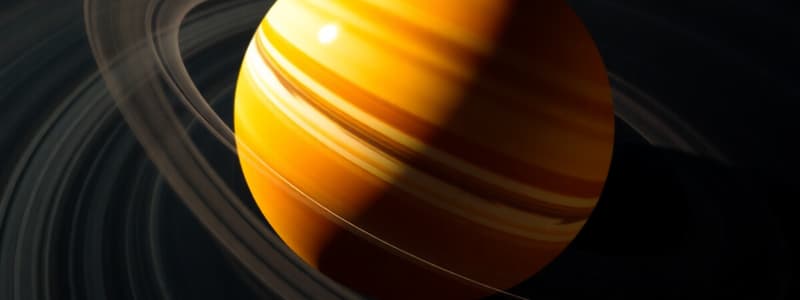Podcast
Questions and Answers
What happens to the boiling point of water as altitude increases?
What happens to the boiling point of water as altitude increases?
- It increases.
- It decreases. (correct)
- It remains the same.
- It fluctuates unpredictably.
What is the Armstrong limit?
What is the Armstrong limit?
- The altitude at which water boils at human body temperature. (correct)
- The height where atmospheric pressure reaches zero.
- The minimum altitude for a parachute deployment.
- The maximum altitude humans can survive without oxygen.
What can happen to bodily liquids at or above the Armstrong limit?
What can happen to bodily liquids at or above the Armstrong limit?
- They become solid.
- They condense into fog.
- They boil away. (correct)
- They freeze instantly.
What is the primary composition of the Sun?
What is the primary composition of the Sun?
What is the baseline temperature of outer space?
What is the baseline temperature of outer space?
How does exposure to very low pressure in space affect humans?
How does exposure to very low pressure in space affect humans?
What percentage of Earth's atmosphere is composed of nitrogen?
What percentage of Earth's atmosphere is composed of nitrogen?
Which gas is present in Earth's atmosphere as a greenhouse gas?
Which gas is present in Earth's atmosphere as a greenhouse gas?
What is the primary advantage of a satellite in low Earth orbit (LEO)?
What is the primary advantage of a satellite in low Earth orbit (LEO)?
Which of the following statements correctly describes the Hubble Space Telescope?
Which of the following statements correctly describes the Hubble Space Telescope?
What did Newton's laws provide in relation to Kepler's laws of planetary motion?
What did Newton's laws provide in relation to Kepler's laws of planetary motion?
Which type of orbit is classified as geostationary?
Which type of orbit is classified as geostationary?
Which of the following is NOT an application of low Earth orbit (LEO)?
Which of the following is NOT an application of low Earth orbit (LEO)?
What effect does Earth's atmosphere have on telescopic observations from ground-based systems?
What effect does Earth's atmosphere have on telescopic observations from ground-based systems?
Which statement about Tycho's observations is correct?
Which statement about Tycho's observations is correct?
What altitude defines low Earth orbit (LEO)?
What altitude defines low Earth orbit (LEO)?
What is a coronal mass ejection (CME)?
What is a coronal mass ejection (CME)?
What type of radiation has enough energy to ionize atoms or molecules?
What type of radiation has enough energy to ionize atoms or molecules?
What does the equation $F = mg$ represent?
What does the equation $F = mg$ represent?
What best describes free fall?
What best describes free fall?
What causes the sensation of weightlessness for an astronaut in orbit?
What causes the sensation of weightlessness for an astronaut in orbit?
What health risks are associated with exposure to ionizing radiation?
What health risks are associated with exposure to ionizing radiation?
What is the normal force?
What is the normal force?
What is an effect of prolonged exposure to lower-level doses of ionizing radiation?
What is an effect of prolonged exposure to lower-level doses of ionizing radiation?
What concept was introduced as an adjustment to Aristotelian physics?
What concept was introduced as an adjustment to Aristotelian physics?
According to the geocentric model, which celestial body revolves around Earth?
According to the geocentric model, which celestial body revolves around Earth?
What phenomenon does Copernicus's heliocentric model help to explain?
What phenomenon does Copernicus's heliocentric model help to explain?
In the equant model, how is the speed of a celestial object described?
In the equant model, how is the speed of a celestial object described?
What is the primary difference between the heliocentric and geocentric models?
What is the primary difference between the heliocentric and geocentric models?
How does Earth's rotation affect the perceived motion of celestial objects?
How does Earth's rotation affect the perceived motion of celestial objects?
Which model resolved the issue of retrograde motion?
Which model resolved the issue of retrograde motion?
What is the main focus of the heliocentric model?
What is the main focus of the heliocentric model?
What describes the celestial spheres as per the uniform circular motion?
What describes the celestial spheres as per the uniform circular motion?
What is the order of celestial spheres from Earth outward based on?
What is the order of celestial spheres from Earth outward based on?
According to Hipparchus, what resolves the inconsistency in the length of the seasons?
According to Hipparchus, what resolves the inconsistency in the length of the seasons?
What is the primary reason for the seasons on Earth?
What is the primary reason for the seasons on Earth?
What concept did Claudius Ptolemy introduce to improve predictions of celestial motions?
What concept did Claudius Ptolemy introduce to improve predictions of celestial motions?
During which solstice does the Sun reach its most northerly position relative to the celestial equator?
During which solstice does the Sun reach its most northerly position relative to the celestial equator?
Which of the following best describes the equant's mathematical concept?
Which of the following best describes the equant's mathematical concept?
What was observed about the lengths of the seasons in the year 2024?
What was observed about the lengths of the seasons in the year 2024?
Flashcards are hidden until you start studying
Study Notes
Uniform Circular Motion
- The celestial spheres consist of aether, which moves uniformly in a circular motion relative to the daily movement of the outer sphere of stars.
- The order of celestial spheres from Earth outward is based on the decreasing orbital periods of the objects they contain.
- The Moon’s sphere exhibits an eastward motion within one month, while the Sun’s sphere moves eastward in one year.
Celestial Mechanics
- Celestial objects display apparent motion around Earth, forming the basis of the geocentric model and Aristotelian physics.
- Observations required adjustments leading to concepts of eccentricity and equant to describe celestial motions.
Ecliptic and Seasons
- The Sun's path forms an ecliptic plane inclined to the celestial equator, influencing seasonal changes on Earth.
- At the summer solstice, the Sun reaches its northernmost point, marking the midpoint of summer.
- Differences in seasonal lengths contradict the assumption of uniform circular motion of the Sun around Earth.
Eccentric and Equant
- Eccentricity, attributed to Hipparchus, suggests a slight offset in the Sun's path, explaining irregular season lengths.
- The equant, developed by Ptolemy, allows for accurate predictions of celestial motions by considering variations in speed relative to an imaginary point.
Copernican Heliocentric Model
- Nicolaus Copernicus proposed a heliocentric system where Earth and planets orbit the Sun, with only the Moon revolving around Earth.
- The apparent daily motion of celestial objects results from Earth's rotation on its axis.
Planetary Retrograde Motion
- The heliocentric model accurately accounts for planetary retrograde motion, which occurs when a planet appears to reverse its eastward drift.
Artificial Satellites
- Artificial satellites are placed in various orbits around Earth, including low Earth orbit (LEO), medium Earth orbit (MEO), geosynchronous orbit, and high Earth orbit (HEO).
- LEO allows for low energy requirements for satellite placement and lower communication latency, facilitating accessibility for services like the Hubble Space Telescope.
Hubble Space Telescope
- The Hubble Space Telescope operates above Earth's atmosphere, capturing high-resolution images and reducing background light interference compared to ground-based telescopes.
- The telescope is maintained in space through multiple shuttle missions, enabling repairs and upgrades.
Armstrong Limit
- The Armstrong limit is the altitude above which atmospheric conditions cause bodily fluids to boil at normal body temperature, approximately 18-19 km above sea level.
- Exposure to low pressure in space can lead to severe bodily harm, such as ruptured lungs and eardrums.
Outer Space Characteristics
- Outer space is characterized by a near-perfect vacuum, low temperatures averaging -270°C, and high levels of radiation.
- The Sun is primarily composed of hydrogen and helium, radiating energy in the form of light.
Ionizing Radiation
- Outer space is filled with ionizing radiation, which can cause cell and tissue damage, leading to radiation sickness or cancers with prolonged exposure.
Weight and Free Fall
- Weight is the force acting on an object due to gravity, calculated as F = mg, where g is the gravitational acceleration.
- When in free fall, such as an astronaut in orbit, gravity is the only force acting on the body, resulting in the sensation of weightlessness and causing nearby objects to appear to float due to simultaneous free fall.
Studying That Suits You
Use AI to generate personalized quizzes and flashcards to suit your learning preferences.




